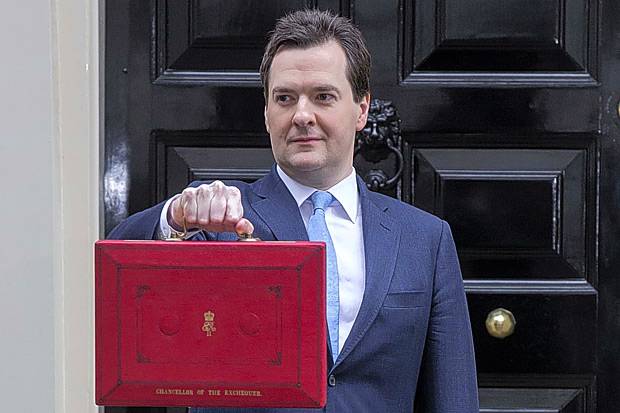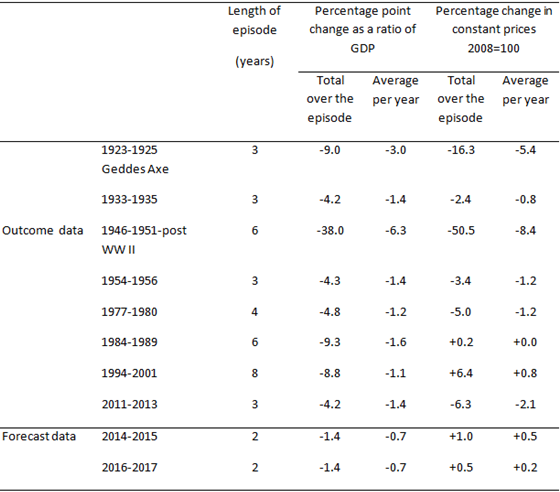At the beginning of this year the Chancellor, George Osborne, announced a proposal to impose spending cutbacks during the next Parliament. The plan announced was for £25bn of spending cutbacks over the period 2015-17 to deal with the UK’s continuing deficit. That deficit-cutting strategy appeared to rely largely on spending cuts (mostly directed at working-age welfare) and little if at all on tax increases.
The table below compares the outcomes of eight selected episodes of UK spending cutbacks over a 90-year period, including the current coalition government’s spending record based on reported figures up to 2013. It also compares those eight historical episodes with the plans announced by Osborne for further spending cuts before and after the UK general election scheduled for 2015, based on the assumptions (a) that those plans would be fully implemented as announced and (b) that the OBR forecasts of GDP up to 2017 proved to be broadly correct. Both assumptions are of course highly contestable.
So the table demonstrates that, in historical perspective, Osborne’s strategy implemented on top of the cutbacks already made by the current coalition government would be unusual but not unprecedented in the length of the fiscal squeeze it would imply (seven years). Nor would it be by any means unprecedented in the depth of spending cutbacks it entailed (an overall 7 percentage point fall in spending relative to GDP between 2011 and 2017, assuming all plans are implemented, but an annual average of only 1).
In spite of how much impassioned talk there has been of austerity on both sides of the party-political divide, the table also suggests that the UK coalition government’s overall cutbacks to date have been modest in comparison with the seven earlier episodes of fiscal squeeze shown. Even if all of George Osborne’s proposals for further cutbacks between 2014 and 2017 were fully implemented, the total percentage point drop in expenditure would rank the current fiscal squeeze in fifth position out of the eight shown in the table. Furthermore, it would still be the lowest of all eight in terms of the annual average percentage point fall and it would also be modest in terms of absolute reductions in constant-price terms, shown in the right-hand columns of the table. For example, the fiscal squeeze that began with the ‘Geddes Axe’ under the UK’s last Liberal-Conservative coalition in 1921-2 (and implemented in the following three years under three different governments) was also based on spending cuts alone, and went far deeper even than the plans announced by George Osborne. The same applies to spending cuts in other countries in more recent times, such as Ireland in the late 1980s, or Sweden, Canada, New Zealand and Germany in the 1990s, which we compare in a forthcoming book When the Party’s Over: The Politics of Fiscal Squeeze in Perspective.
Selected Episodes of UK Expenditure Cutbacks Based on Actual Outcomes (1920-2013) and Proposed Cuts (2014-2017)
Sources: Outcome data for1920-1980 based on Mitchell (1988), Chapter XI, Chapter XVI; 1981-2013 based on Public Finances Databank January 2014, OBR. Forecast calculations based on data from 2013-2017 in Economic and Fiscal Outlook December 2013, OBR, Tables 4.1 and 4.19. All GDP deflator figures taken from Lawrence H. Officer and Samuel H. Williamson, ‘What Was the U.K. GDP Then?’ MeasuringWorth, 2012 with values for 2013 and beyond are extrapolated linearly from deflator figures for 2005-2012.
But as with the Geddes Axe initiated by David Lloyd George, George Osborne’s announced plans are a party-political gambit and not just a technocratic one. Nor is the gambit new. After all, Conservative governments went into both the 1992 and 1997 general elections by announcing sharp expenditure restraint for the following Parliament, thus forcing the Labour opposition to either reject or accept those overall spending targets. When Labour chose to reject the targets in 1992, the incumbent Conservatives were able to successfully campaign on the slogan of ‘Labour’s tax bombshell’. When Labour chose to accept the targets in 1997, incumbent Conservatives aimed (much less successfully in that case) to challenge Labour to identify what extra cuts or tax rises they would impose to meet their election promises to specific groups unsuccessfully. (The Conservatives then watched with surprise for the first few years of the Blair government as Gordon Brown stuck to spending targets that even many Conservatives privately regarded as unrealistic).
So far, then, so familiar. But this time there is at least one thing that is different from those campaigns of the 1990s, and that is the referendum on Scottish independence in September, some eight months or so before the due date of the next UK general election. Here the electoral logic applying to UK general election competition may diverge sharply from that applying to that upcoming referendum.
The 1990s electoral tactic of announcing drastic future expenditure targets and forcing Labour to accept or reject them is designed for an electoral battleground for the swing voters in the marginal seats in contention between Labour and the Conservatives, almost all of which are in England. But the referendum battle over the future of the UK concerns Scotland-based voters alone, and the outcome of the independence referendum is likely to be determined by the current 10 or 15 per cent of the ‘don’t know’ Scottish electors, mostly in Scotland’s central belt. Those voters seem much less likely than swing voters in the south of England to be attracted to spending-cap politics, and predictably the ‘Yes’ camp has already seized the opportunity to remind those swing Scottish voters in no uncertain terms about the extent of spending cuts (heavily directed on benefits to the working poor and unemployed) that staying in the UK might be expected to entail if George Osborne’s plans were implemented.
Other factors will determine the outcome of the Scottish independence referendum in eight months’ time, though polls do seem to suggest that ‘pocket book’ issues are important for swing voters in the referendum. But if the Conservatives’ 1990s electoral tactics of presaging draconian expenditure restraint for the future unintendedly help to swing enough of those undecided Scottish voters into voting Yes in September, the spending-cap electoral battleplan may play out rather differently from the way it did in the 1990s. This raises further imponderables. If a majority of those voting in Scotland this September do vote Yes, could there feasibly be a UK general election some eight months later, in the middle of independence negotiations for splitting up the country? Or, as the SNP’s Angus Robertson has suggested, would that general election in fact have to be postponed until after Scottish independence in 2016 (at least according to Alex Salmond’s proposed timetable)? And if that was the case, what sort of caretaker government could be installed in Westminster, and what expenditure policy would it be able to pursue? There are no clear answers to those questions, but the stakes in spending-cap politics may prove to be higher in the mid-2010s than they were in the 1990s.
Christopher Hood, and Rozana Himaz are co-editors (together with David Heald) of the forthcoming book When the Party’s Over: The Politics of Fiscal Squeeze in Perspective, due to be published by Oxford University Press for the British Academy later this year.
This post originally appeared on the LSE’s British Politics and Policy blog.










3 Comments